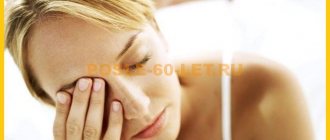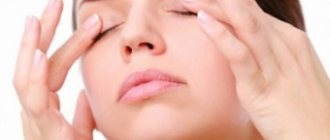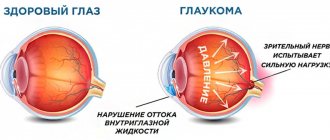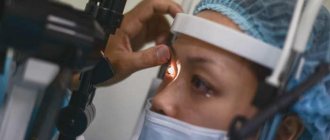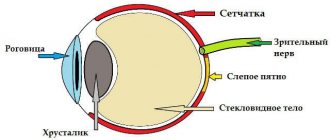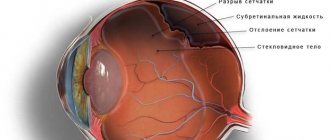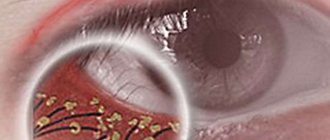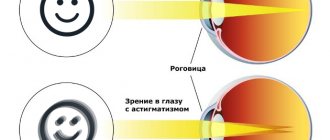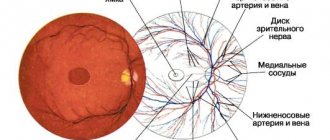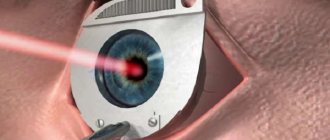Hypotony of the eyeball or low intraocular pressure occurs due to injury or detachment of the retina. The pathological process leads to disruption of fluid production inside the organs of vision. The tone of the soft tissues gradually decreases, which gradually leads to the development of opacities and hemorrhages of the vitreous body. Due to hypotension, the eye slowly decreases in size and loses its spherical shape.
Share
Tweet
Share
Cool
Send
How is it measured?
A tonometer measures eye pressure in medicine. The procedure for checking the intraocular fluid is called tonometry and is carried out to identify a dangerous disease of the visual organs - glaucoma. The tonometer device records the degree of elasticity of the eye shell. Before the procedure, the patient is instilled with eye drops containing an anesthetic to avoid discomfort. There are several types of tonometry:
- direct palpation or through the eyelids;
- transpalpebral tonometry;
- Goldman method;
- electrotonography;
- applanation tonometry according to Maklakov;
- corneometry or pachymetry (measurement of corneal thickness).
There are several methods for determining IOP:
- Contact. Measurement with a tonometer: applanation;
- impressionistic;
- contour dynamic.
Before diagnosing IOP, drops of anesthesia are instilled into the patient, and then the measurement is quickly and painlessly taken with a tonometer.
The first method is used by many ophthalmologists. The patient is given eye drops to give local anesthesia. After which all the liquid is forced out of the eye chamber using a tonometer. For this method, various types of devices are used: Maklakov weight, Scholz tonometer, Goldmann, Icare. The dynamic contour device gives less accurate indicators than the previous ones. Measurements are carried out quickly and painlessly for humans.
If pressure cannot be measured using instruments due to injuries, then they resort to the palpation method. To do this, close your eyes and lower the pupil down. The doctor presses on the eyelid with two index fingers. If a pulsation is clearly felt when pressing lightly, then the IOP is normal. With increased pressure, you need to apply more force to press.
The method of non-contact measurement of eye pressure is increasingly being used. To do this, special equipment is used, and pressure on the eye is carried out using a stream of air. The received information is processed on a computer. This method is extremely effective and does not have negative consequences for the patient.
Symptoms of IOP
A person may not feel symptoms at the initial stage of the disease, which is manifested by heaviness in the eyes and increased fatigue. Such signs are explained by lack of sleep or overwork of the body, but if after rest the symptoms remain, then treatment is necessary. As the disease progresses, it becomes noticeable, causing discomfort to the person. The signs of eye pressure described below will help determine an increase in the indicator:
- a sharp decrease in visual acuity;
- the appearance of bradycardia;
- cloudiness, hazy vision;
- rainbow circles before the eyes;
- severe headaches in the temples or around the eyes;
- dizziness;
- corneal edema;
- lack of pupil reaction to light.
Eye pressure - the symptoms and treatment of which can be suggested by a doctor, is characterized not only by an increase, but also by a decrease in ophthalmotonus. Low reading is less than 10 mm Hg. Art. called ocular hypotony. Symptoms of intraocular pressure due to infection, inflammation and dehydration:
- dryness;
- stop shining;
- sometimes the eyeballs sink;
- gradual deterioration of vision.
Signs of the disease include noticeable red capillaries in the eyes.
If the normal pressure is violated, the eyes react painfully to light. These are common symptoms of high IOP. If the pressure is increased, then red capillaries are noticeable in the eyes, nausea and tearfulness appear. Headaches and dry eyes are also signs of hypotension. If there are violations, the child’s memory and attention deteriorate, and loss of consciousness is possible. Children become lethargic, sleepy and apathetic.
Symptoms and treatment of high type eye pressure are more dangerous to health. As is the case with signs of hypotension, it is difficult to determine and feel the change with increased intraocular pressure. Without a specialist, it will not be possible to identify gradual degenerative changes in the eye that begin with too high pressure.
There are three types of hypertension dynamics:
- stability. High levels remain for a long period without changing - the main sign of the development of glaucoma;
- lability. Iphthalmotonus either jumps or returns to normal;
- transitivity. Hypertension occurs once and then disappears, most often on its own.
Externally noticeable changes in the eyes with increased intraocular pressure:
- if you look at the photo, you will notice burst blood vessels in people suffering from this condition, and as a result, red eyes;
- tearfulness.
It affects your well-being in the following way: nausea and profuse vomiting appear if the negative state lasts for a long time. Frequent headaches appear, localized in the frontal part, near the eyes and temples, and a feeling of constriction appears. A sick person notices clouding of the visual image, blurriness, and it becomes difficult to see anything at night.
How to identify emerging glaucoma:
- subtle superficial changes in the outer shell of the cornea, which become obvious in the last stages;
- aching, cutting, severe pain in the eyeball;
- vomiting, nausea;
- constant pain in the head, worsening in the temporal and frontal region, around the eyes;
- Red eyes;
- When looking at bright, colored objects, streaks and black spots appear.
Why is it important to pay attention to the signs? This will help return the pressure to normal without consequences, and if glaucoma develops, it will be cured without surgery.
Why is this indicator very significant for doctors?
Intraocular pressure straightens the structures of the eye, maintains the tone of soft tissues and stabilizes the permeability of the choriocapillaris. Thanks to IOP, the retina remains in one position throughout life. Pressure indicators exist as a result of the synthesis and outflow of intraocular fluid. Normal IOP levels range from 11 to 21 mmHg. Art. As the pathological process develops, visual acuity and eye pressure change first.
Thanks to IOP fluctuations, ophthalmologists can determine the type of disease and prescribe a treatment regimen in a timely manner. If pressure readings increase, there is a risk of developing glaucoma. Hypotony of the eyeball indicates loss of soft tissue tone and impaired production of intraocular fluid.
What causes eye pressure to increase?
With normal indicators, the eye is not subject to stress and the person feels normal without any symptoms. When malfunctions occur in the body, the secretion of natural fluids from the organs of vision increases, and the functioning of the cardiovascular system is disrupted. This leads to jumps in the indicator. The cause of symptoms may be anatomical changes in the organs of vision.
Other causes of increased intraocular pressure:
- the presence of atherosclerosis;
- farsightedness;
- disruption of the heart and blood vessels;
- hereditary factor;
- stressful situations;
- emotional stress;
- past illnesses;
- severe mental or physical stress.
Prevention methods
To reduce the risk of increased intraocular pressure, you must adhere to the following rules:
- spend more time outdoors;
- do not abuse alcohol;
- do not deprive the body of healthy and full sleep;
- limit consumption of fried and fatty foods;
- after intense visual work, give your eyes a rest;
- monitor the water balance in the body.
It is also useful to regularly perform eye exercises. After a hard day, it will help relieve fatigue and restore visual function.
It is important to understand that various eye pathologies make themselves felt when changes become almost irreversible. Therefore, it is regularly necessary to have your eyesight checked and IOP measured by an ophthalmologist.
Treatment of disorders
Minor fluctuations in ophthalmotonus do not require treatment, since they do not affect visual acuity. When serious symptoms appear, the question arises, how to treat eye pressure? The doctor prescribes medications, during which it is necessary to adhere to preventive measures, for example: sleep on high pillows, do not be exposed to prolonged stress, take brisk walks. You can get rid of the disease and treat eye pressure at home, using folk remedies, or resort to laser therapy.
At the first signs of the disease, parents should contact an ophthalmologist. You can't ignore the problem, thinking it's just fatigue. Without treatment, abnormal blood pressure leads to vision loss. Restoration of eye pressure is provided by drops: “Oftolik”, “Vizin”, “Taufon”. They also prescribe medications such as Fotil, Pilocarpine, and Travoprost. All these medications are aimed at restoring fluid circulation in the eyes. Additionally, doctors advise taking dietary supplements:
- "Blueberry forte";
- "Okuwait Lutein";
- "Super optic."
At home, a tincture of pear root, nettle and sleep herb will help reduce blood pressure. It is recommended to take the decoction 3 times a day. In addition, brew motherwort (15 grams per 250 ml), let it brew and take 1 teaspoon before meals. It is recommended to wash your eyes with aloe juice 3-4 times a day. Doctors recommend doing eyelid massage, paying more attention to walks outside and eating right.
To return high levels to normal, an ophthalmologist suggests the patient take medications orally: Pilocarpine, Travaprost, Fotil.
If poor health is caused by eye strain, and a person is often engaged in work that requires visual concentration, then the following drops are chosen for treatment: “Vizin”, “Oftolik”, “Taufon”.
Complex treatment may include dietary supplements:
- "Blueberry forte";
- "Super Optic";
- "Lutein Complex";
- “Immerse.”
If necessary, the doctor also gives instructions for special exercises for the eyes, which must be done daily.
Folk remedies for oral use
Treatment with folk remedies is usually recommended for patients with contraindications to traditional drugs to reduce eye pressure. For internal use, you can use the following recipes:
- You will need 3 teaspoons of dried calendula flowers, pour 500 ml of boiling water, leave for about two hours. Then the infusion needs to be filtered. Use half a glass no more than 4 times a day. It can also be used as a lotion liquid.
- The healing properties of woodlice have been known since ancient times. About 8 kg of the plant needs to be squeezed in a juicer. The result is approximately 6 liters of juice. 600 g of alcohol should be added to it. The product must be stored in the refrigerator. Take 50 g of it before meals, after diluting it with water in a 1:1 ratio. The duration of such treatment is 2 months.
The folk remedies for eye pressure listed in the article are best used together with drug therapy and only after consultation with a doctor. In this case, you can hope for a quick recovery and no complications. Doctors' prescriptions should not be taken as a complete alternative to medications.
Medicine for eye pressure
Therapeutic techniques that cannot be prescribed to yourself will help reduce ophthalmotonus. Only an ophthalmologist can prescribe medications for eye pressure. During the consultation, you will undergo an examination that will help you find out the type of disease and select effective medications that normalize your indicators. There are 3 types of medications that are used to treat high IOP in adults:
- Medicines that can be used to open other pathways for the outflow of fluid.
- Medicines that help reduce fluid production inside the eye.
- Preparations to improve the circulation of ocular fluid (tablets, drops).
How to lower eye pressure at home
How to relieve eye pressure at home without resorting to medications? If the pathology has just begun to manifest itself, then by taking simple preventive measures, you can eliminate the risk of complications. To do this, you need to avoid wearing clothes that block the flow of blood from the veins of the head (do not wear ties, do not wear tight collars). In addition to restrictions on physical and mental activity, you can lower eye pressure at home in the following ways:
- do not tilt your body down;
- give up alcohol and cigarettes;
- exclude coffee, tea, salt;
- do not drink a lot of liquid;
- light massage on the upper eyelids.
